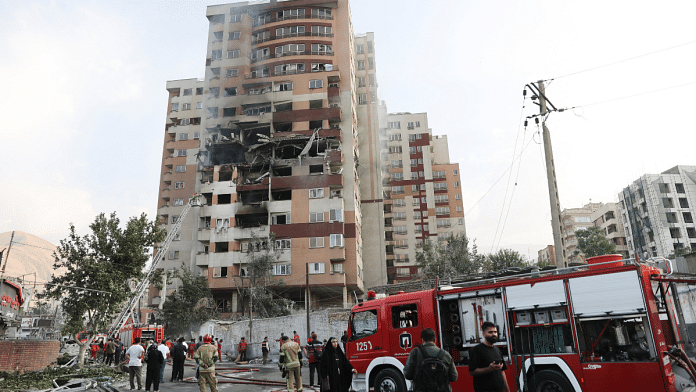Caught mid-pivot between war and peace, Iran retaliated with drone swarms, mainly Shahed 136s, triggering an emergency in Israel. Airspaces are sealed. The Middle East, already seething since October 2023, exploded once more into flames.
One could foresee what was coming. I had tweeted just hours before the strikes that a tepid deal—engineered not with foresight but with political expedience—between Washington and Tehran would push Israel to go solo, and it did. Any deal at this stage would not have rolled back Iran’s nuclear enrichment capability in any meaningful way. That, more than anything else, rattled the Israeli strategic psyche.
Since the bloody incursion by Hamas on 7 October 2023, Israel has systematically dismantled the architecture of Iran’s regional influence—from Hamas to Hezbollah and Iran itself. Yet Iran’s nuclear ambitions have persisted, undeterred and, in Israel’s eyes, this is intolerable. A bomb in Iranian hands is not just a regional issue for Tel Aviv—it is an existential one.
At the heart of this combustible moment lies a familiar, disruptive figure—Donald Trump.
For all the chaos he creates, Trump remains a creature of remarkable predictability. If there is a consistent hallmark to his foreign policy, it is his unrelenting obsession with cutting headline-grabbing deals. Not deals for stability, not deals for long-term strategic coherence, not even those in America’s long-term interests. He is always in search of deals that play well in a rally, that fill airtime, that bear his signature with the theatrical flourish—of a man forever trying to make America great again and in that course to win a Nobel Peace prize.
Trump’s willingness to once again pursue talks with Iran—despite having torpedoed the 2015 Joint Comprehensive Plan of Action himself in 2018—epitomises this brand of transactional statecraft. Back then, Iran’s enrichment levels hadn’t even crossed the 20 per cent mark. Today, the situation is drastically more alarming. The International Atomic Energy Agency (IAEA) reported just last month that Iran has amassed over 408 kilograms of uranium enriched to 60 per cent—dangerously close to weapons-grade. Enough, experts say, to create multiple nuclear warheads, should it choose to.
Yet Trump, hungry for a legacy flourish ahead of November mid-term governor’s elections, seemed willing to ignore the material shifts in Iran’s capability, the crumbling credibility of American commitments, and the region’s red lines—Israel’s most of all.
And so, Israel, reading the wind, acted.
This isn’t the first time Trump has defied counsel to pursue his ego over expertise. In 2018, his own top brass—including Secretary of State Rex Tillerson, National Security Advisor HR McMaster and Secretary of Defence James Mattis—advised against withdrawing from the JCPOA, and he ignored them. The results were predictable: Iran returned to enrichment, the US lost leverage, and allies began to hedge their bets.
Now, as Trump once again toys with the idea of detente, the stakes are astronomically higher—and Israel and others know it. Opting for political neutrality, both Saudi Arabia and Jordan have been intercepting Iranian drones over their airspace that are flying to Israel.
But Trump remains impervious. Whether it’s undermining NATO, bullying Canada, slapping tariffs on India, or rebuking Europe, his conduct abroad has long revealed a pattern: Friends are optional, optics are everything. His tweets continue to frame him as a master statesman—while allies quietly reflect on his reliability, if not his sanity.
As chaos unfolds, Washington is already bracing. The Pentagon has ordered the withdrawal of diplomatic staff from Baghdad, Kuwait, and Bahrain. These aren’t gestures of confidence—they are signs of apprehension. As are emphatic statements made by American generals on Pakistan being a “phenomenal counter terrorism” partner. This courting is likely done lest the war escalates to a level that the US has to intervene militarily.
Israel’s airstrikes, meanwhile, were not haphazard but surgical. The IDF has issued a clearly worded explainer on what it intends to do and why. It minces no words to say that following the IAEA report, Iran is merely “moments” away from a nuclear bomb, and the purpose of Operation Rising Lion is to destroy those nuclear enrichment sites. In addition, it stated unambiguously that the Islamic regime is the main target for pursuing a clandestine nuclear enrichment program.
While the nuclear site Natanz was struck hard, Fordow—the fortified underground site—remains apparently operational, perhaps too well-shielded for a conventional assault. Fordow, it must be noted, was off-limits under the original JCPOA, yet has emerged as a crucial node in Iran’s enrichment network. The longer the deal has languished, the deeper Iran has dug in—literally and figuratively.
As Iran retaliates, the question that haunts the geopolitical horizon is: Where is it going?
Iran’s retaliation, reportedly over 100 Shahed-136 drones, may well escalate. Already, the Israeli Defense Forces claim to be intercepting threats beyond its borders, and unspoken coordination with Saudi Arabia and Jordan suggests that the lines of neutrality are blurring in reality, even though the optics of neutrality are maintained.
Much hinges on whether Iran, cornered and humiliated, decides to strike US assets, thus dragging Washington into a deeper conflict. Would such an escalation delay the bomb—or accelerate the sprint toward it? And what of Iran’s regime, already battered post-October 2023? Can it survive another round of regional humiliation?
We don’t yet know. But we can guess this: Israel seems to have invested decades in cultivating deep intelligence networks inside Iran. It has been preparing for this moment, even as the rest of the world talked and tweeted and mediated.
As the fire spreads across the region, India looks at this situation with discomfort.
For years, New Delhi has balanced a delicate web of interests in the Middle East. It has invested strategically in Iran’s Chabahar port to bypass Pakistan, while simultaneously deepening ties with Israel through partnerships like I2U2 and IMEC. The Adani Group’s investment in Haifa Port is not incidental; it is emblematic of India’s bet on Israel’s long-term role in regional logistics and security. Israel’s rise in India’s defence industry imports has been rather meteoric and a significant variable in our diversification away from decades of dependence on Russia, while bolstering indigenisation efforts.
And yet, India is also deeply entwined with the Gulf—Emiratis, especially, then Saudis and Qataris. Its abstention from the latest on Gaza ceasefire speaks volumes: neutrality, in this case, is not indecision, but the safest strategy.
If Iran capitulates or agrees to a verifiable rollback of its nuclear programme, India stands to benefit—from restored oil trade and renewed use of the International North-South Transport Corridor to fewer sanctions fears throttling connectivity projects. But India also wants the Red Sea to calm down. The Houthi threat has rendered Bab-el-Mandeb nearly impassable for Indian vessels. Since October, Indian cargo has been forced to detour via the Cape of Good Hope, driving up costs and time, despite Indian EAM’s quick trip to Tehran to get the same guarantees from Houthis as they had given to Russian and Chinese ships.
Therefore, anything that weakens Iran’s proxies—especially the Houthis—is a win for India’s economic calculus and connectivity aspirations.
At a wider geostrategic level, there’s another layer to consider—Russia.
With Assad in Syria gone, Hezbollah leadership thinned, and Iran reeling, Moscow’s network of partners across the Middle East is beginning to unravel. While Russia may posture from afar, the reality is that its strategic footprint is shrinking. That’s a story for another day—but one not far off.
And what of Trump? Last I checked, he was tweeting his advice, still convinced in the power of his personality over other world leaders and hardliners. By now, most leaders see through Trump and play him. They try to hedge their bets to keep him appeased on the one hand and pursue their brute interests on the other.
The Art of the Deal may have sold millions of copies, but it is painfully outdated in a world that now demands vision, not vanity; collaboration, not coercion. The world has changed—but the author hasn’t.
As Operation Rising Lion rages on and the Middle East enters another phase of uncertainty, one truth stands tall amid the smoke: Real leadership is not in the deal, but in the direction.
And for now, the world is still waiting for someone to lead it.
(Edited by Theres Sudeep)








